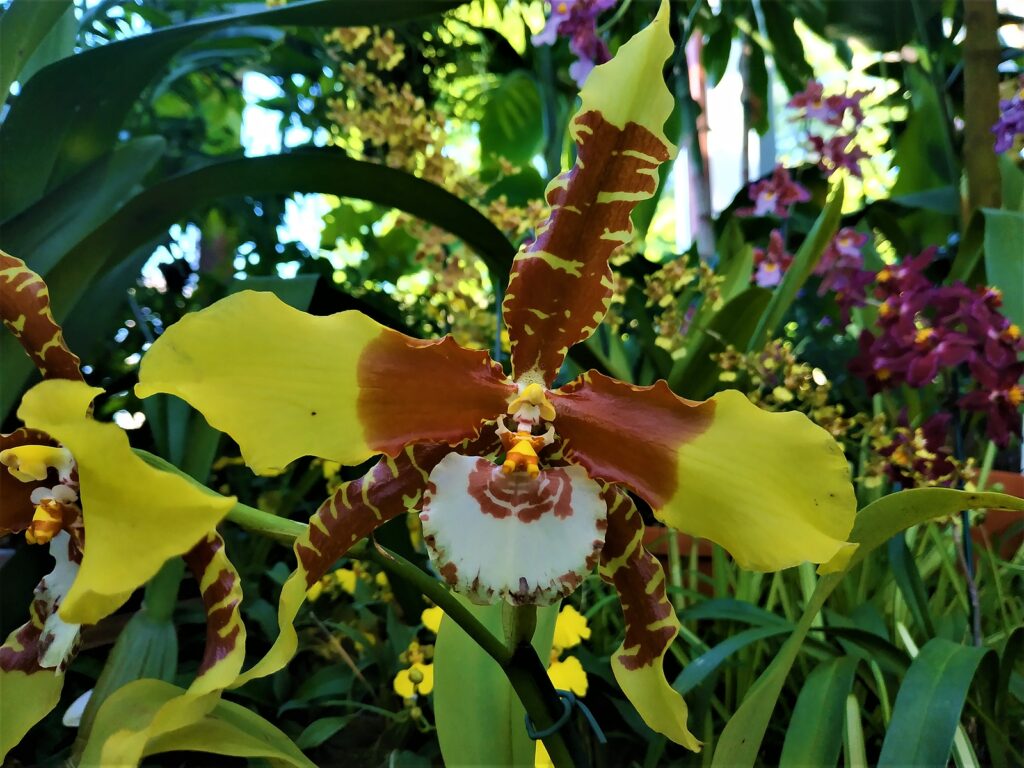Odontoglossum is a genus of epiphytic orchids that bear ruffled flowers that are generally white but also yellow, brown, or pink. Flowers are borne on erect or arching stalks; a vigorous plant may even produce 2 flower stalks per pseudobulb, usually 12 or more flowers in a raceme.
Odontoglossum needs bright light but not direct sunlight. It wants lots of moisture throughout the year. Odontoglossum blooms best when its roots are crowded. It usually blooms as least twice a year.
Odontoglossum is a genus of about 200 species. There are numerous hybrids as well.
Get to know Odontoglossum
- Plant type: Epiphytic orchid
- Growing zones and range: Zones 13-15
- Optimal growing temperature: day, 80°F (27°C); night, 50° to 55°F (10° to 13°C).
- Height and width: 12 to 36 inches (30-90cm) tall, 8 to 12 inches (20-30cm) wide depending on the variety.
- Foliage: Thin, leathery leaves; leaves are usually folded .
- Flowers: Ruffled flowers are generally white, yellow, brown, or pink; flowers are borne on erect or arching stalks; a vigorous plant may even produce 2 flower stalks per pseudobulb; usually 12 or more flowers in a raceme; indiviual flowers have clawed lips and five spreading petals.
- Bloom time: Almost any time of the years
- Uses: Houseplant, tropical garden
- Common name: Odontoglossum
- Botanical name: Odontoglossum
- Family name: Orchidaceae
- Origin: Central and South America

Where to plant Odontoglossum
- Light: Odontoglossum needs bright light from southern exposure; shade from direct summer sun at midday. Thin-leaved species always require some shade. 0.cgrande requires more light than other species. Small plants, and especially hybrids, do well under artificial light, needing 12 to 16 light-hours daily. Good circulation of fresh air.
- Soil: Pot Odontoglossum in Osmunda fiber or orchid bark mix; fine grade bark is needed to suit the fine root system.
When to plant Odontoglossum
- Set Odontoglossum outdoors in tropical and subtropical regions at any time of the year.
Planting and spacing Odontoglossum
- Space Ondontoglossum 8 to 12 inches (20-30cm) apart depending on the varity.
How to Water and Feed Odontoglossum
- Water: Keep the growing medium evenly moist in the home; allow the medium to dry slightly between waterings in the greenhouse. Mist frequently. Humidity of 50% to 70% is best.
- Feeding: Feed Ondontoglossum with an all-purpose fertilizer while in active growth. Plants in Osmunda fiber require monthly feedings; plants in orchid bark mix need feeding every 3 weeks.
Odontoglossum care
- In general, plants with hard pseudobulbs require longer rest period after flowering than those with soft pseudobulbs. Reduce water, never allowing pseudobulb to shrivel; provide bright light.
Growing Odontoglossum as a houseplant
- Odontoglossum prefers cool temperature and high humidity.
- Place them in bright light in summer and in direct light the rest of the year.
- Pot Ondontoglossum in a growing mix designed for orchids, one to which fir or redwood bark or osmunda fiber has been added; keep the medium evenly moist.
- Fertilize monthly using a complete fertilizer.
Odontoglossum pests and diseases
- Check Ondontoglossum for bacterial, fungal, and viral infections.
- Mealybugs, scale, slugs, snails, whiteflies, and spider mites may attack Odontoglossum.
Odontoglossum propagation
- Divide Ondontoglossum when plant fills the pot and flows over the sides.
Odontoglossum varieties to grow
- 0dontoglossum bictonienese produces an abundance of pale green or yellow flowers flecked with brown; lip is violet or white; blooms from late fall to spring.
- 0. grande, clown or tiger orchid. Stems tilt at an angle; sepals carry alternating yellow and brown bands; petals are brown at base, tipped with yellow; wavy-edged lip is white with brown flecks; blooms in fall and winter.
- 0. pulchellum, lily-of-the-valley orchid. Bears 8 to 10 fragrant white flowers; lip has yellow base with red speckles; blooms appear in fall and winter.
- O. rossii. Compact plant, carries clusters of 1 to 5 flowers; sepals are yellow with rich brown flecks; petals are white with brown flecks at the base; ruffled lip is white or light pink, blooms in spring.















